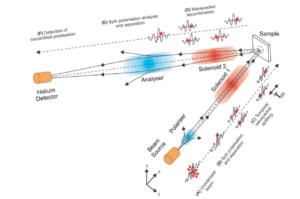The group currently focuses on three main research activities:
1. Studying ultra-fast motion on surfaces using the helium spin echo spectrometer.
Surfaces, even at very low temperatures, are an extremely dynamic environment characterized by a combination of translational (diffusion) and vibrational motion. The mobility of atoms and molecules on a surface plays a crucial role in determining various properties and applications, examples include, heterogeneous catalysis (whether in inter-stellar media or in an industrial process), thin film growth, surface friction, surface based nano-technology devices and many more.
Under many conditions the surface motion is extremely fast, i.e. atoms and molecules travel atomic distances within a few pico-seconds, making it very difficult to measure the surface dynamics. In our group we have built a helium spin echo spectrometer (HeSE), which is capable of measuring atomic scale motion on these time scales. This instrument is essentially a large atom interferometer which uses magnetic manipulations to separate the wave function of the helium atoms in time and space, and measure the time dependent interference pattern of helium atoms scattered from the surface we wish to study.
Further reading: Examples for surface studies performed with the helium spin echo technique.
 Phys. Chem. Chem. Phys., 2009, 11, 3355-3374
Phys. Chem. Chem. Phys., 2009, 11, 3355-3374
2. Using magnetically manipulated molecular beams for ultra-sensitive NMR measurements.
Hydrogen atoms, like many other atoms, are characterized by a nuclear spin state, a property which is the basis for the nuclear magnetic resonance (NMR) technique and its more widely known medical application – magnetic resonance imaging (MRI). Molecules which contain hydrogen atoms can exist in various quantum states which depend on the nuclear spins of the hydrogen atoms, these different states are called spin-isomers, a well-known example is the hydrogen molecule which exists as ortho and para H2 .
Under normal circumstances the molecules are found as mixtures of the different spin-isomers. With the exception of molecular hydrogen, it is difficult to separate these mixtures and study or exploit the special properties of the pure spin-isomer states. In particular, the spin-isomers of water, which are relevant for astrochemistry studies, NMR experiments and various other applications, could not be separated until recently.
In our group, we have developed a separation technique for ortho-water which is based on magnetic manipulation of molecular beams. Our ability to produce a molecular beam of high purity ortho-water, opens many new applications and research activities. One major project we are working on, is combining the ortho-water source with an NMR apparatus where the idea is to exploit the hyper-polarization of the water molecules to get a dramatic increase in NMR sensitivity. Our aim is to increase the NMR sensitivity to a degree where NMR measurements of a single layer of water molecules become possible, measurements which are impossible using existing technology.
Further reading: Ortho-water separation experiments.
3. Controlling and resolving molecular rotations in a molecule-surface collision.
We have recently performed a different type of molecular beam experiment, which opens up a completely new research direction. These experiments are aimed at studying quantum-state-resolved collisions of molecules with surfaces, a fundamental topic which lies at the heart of heterogeneous chemical reactions. Our new method uses a modified HeSE apparatus (mentioned above) to perform matter-wave interferometry of the molecular quantum states. Unlike existing approaches, our new technique does not rely on specific photo-excitation schemes, instead it exploits the rotational magnetic moment, which is a general property of molecules. Consequently our approach can be applied to a wide range of ground state molecule-surface systems and promises to provide unique empirical insight into the steric nature of the molecule-surface interaction potentials. As a first demonstration of this technique we performed experiments with ground state hydrogen molecules colliding with different copper surfaces. Our experiments demonstrate control of the rotational quantum state of the hydrogen molecule and the ability to study the stereodynamics of the molecule-surface interaction [Nature Communications, 8, 15357(2017)].
Further reading: Rotational control experiment.